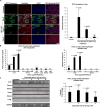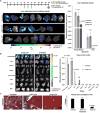Local and transient gene expression primes the liver to resist cancer metastasis
- PMID: 27831902
- PMCID: PMC5512420
- DOI: 10.1126/scitranslmed.aag2306
Local and transient gene expression primes the liver to resist cancer metastasis
Abstract
The liver is the primary site of metastasis for gastrointestinal cancers and is a location highly susceptible to the establishment of metastasis in numerous other primary cancers, including breast, lung, and pancreatic cancers. The current standard of care typically consists of primary tumor resection and systemic administration of potent but toxic chemotherapeutics, yielding a minimal improvement in the median survival rate. CXCL12, a chemokine, is a key factor for activating the migration/survival pathways of CXCR4+ cancer cells and for recruiting immunosuppressive cells to areas of inflammation. Therefore, reducing CXCL12 concentrations within the liver has the potential to decrease tumor and immunosuppressive cell activation/migration within the liver. However, because of off-target toxicities associated with systemic administration of anti-CXCL12 therapies, transient and liver-specific expression of a CXCL12 trap is necessary. To address this challenge, we developed a lipid calcium phosphate nanoparticle optimized for delivering plasmid DNA, encoding an engineered CXCL12 protein trap, to the nucleus of liver hepatocytes. This pCXCL12-trap formulation yielded transient (4 days) liver-specific expression, which greatly decreased the occurrence of liver metastasis in two aggressive liver metastasis models, including colorectal [CT-26(FL3)] and breast (4T1) cancers. Subsequent studies in an aggressive human colorectal liver metastasis model (HT-29) decreased the establishment of liver metastasis more effectively than did systemic administration of the CXCL12 protein trap and to a level comparable to a high-dose regimen of a potent CXCR4 antagonist (AMD3100).
Copyright © 2016, American Association for the Advancement of Science.
Conflict of interest statement
Figures








Similar articles
-
Liver specific gene immunotherapies resolve immune suppressive ectopic lymphoid structures of liver metastases and prolong survival.Biomaterials. 2017 Oct;141:260-271. doi: 10.1016/j.biomaterials.2017.07.007. Epub 2017 Jul 6. Biomaterials. 2017. PMID: 28700955 Free PMC article.
-
Inhibiting cancer metastasis with water-solubilized membrane receptor CXCR4QTY-Fc as a molecular trap.Cell Chem Biol. 2025 Aug 21;32(8):1058-1074.e6. doi: 10.1016/j.chembiol.2025.07.006. Cell Chem Biol. 2025. PMID: 40845831
-
Inhibition of CXCR4/CXCL12 signaling axis by ursolic acid leads to suppression of metastasis in transgenic adenocarcinoma of mouse prostate model.Int J Cancer. 2011 Oct 1;129(7):1552-63. doi: 10.1002/ijc.26120. Epub 2011 Jul 20. Int J Cancer. 2011. PMID: 21480220
-
Focus on the role of the CXCL12/CXCR4 chemokine axis in head and neck squamous cell carcinoma.Head Neck. 2013 Dec;35(12):1819-28. doi: 10.1002/hed.23217. Epub 2013 Mar 6. Head Neck. 2013. PMID: 23468253 Review.
-
Lipid Nanoparticles-Based Therapy in Liver Metastasis Management: From Tumor Cell-Directed Strategy to Liver Microenvironment-Directed Strategy.Int J Nanomedicine. 2023 Jun 2;18:2939-2954. doi: 10.2147/IJN.S402821. eCollection 2023. Int J Nanomedicine. 2023. PMID: 37288351 Free PMC article. Review.
Cited by
-
CXCL12-mediated HOXB5 overexpression facilitates Colorectal Cancer metastasis through transactivating CXCR4 and ITGB3.Theranostics. 2021 Jan 1;11(6):2612-2633. doi: 10.7150/thno.52199. eCollection 2021. Theranostics. 2021. PMID: 33456563 Free PMC article.
-
Hepatoma-intrinsic CCRK inhibition diminishes myeloid-derived suppressor cell immunosuppression and enhances immune-checkpoint blockade efficacy.Gut. 2018 May;67(5):931-944. doi: 10.1136/gutjnl-2017-314032. Epub 2017 Sep 22. Gut. 2018. PMID: 28939663 Free PMC article.
-
Nanoparticle-based approaches to target the lymphatic system for antitumor treatment.Cell Mol Life Sci. 2021 Jun;78(12):5139-5161. doi: 10.1007/s00018-021-03842-6. Epub 2021 May 8. Cell Mol Life Sci. 2021. PMID: 33963442 Free PMC article. Review.
-
Circulating Tumor Cells in Hepatocellular Carcinoma: A Comprehensive Review and Critical Appraisal.Int J Mol Sci. 2021 Dec 3;22(23):13073. doi: 10.3390/ijms222313073. Int J Mol Sci. 2021. PMID: 34884878 Free PMC article. Review.
-
Immune modulation of liver sinusoidal endothelial cells by melittin nanoparticles suppresses liver metastasis.Nat Commun. 2019 Feb 4;10(1):574. doi: 10.1038/s41467-019-08538-x. Nat Commun. 2019. PMID: 30718511 Free PMC article.
References
-
- American Cancer Society. Cancer Facts and Figures 2012. American Cancer Society Inc.; 2012. pp. 25–26.
-
- Zeelenberg IS, Stalle L Ruuls-Van, Roos E. The chemokine receptor CXCR4 is required for outgrowth of colon carcinoma micrometastases. Cancer Res. 2003;63:3833–3839. - PubMed
-
- Kucia M, Reca R, Miekus K, Wanzeck J, Wojakowski W, Janowska-Wieczorek A, Ratajczak J, Ratajczak MZ. Trafficking of normal stem cells and metastasis of cancer stem cells involve similar mechanisms: Pivotal role of the SDF-1-CXCR4 axis. Stem Cells. 2005;23:879–894. - PubMed
Publication types
MeSH terms
Substances
Grants and funding
LinkOut - more resources
Full Text Sources
Other Literature Sources
Medical

